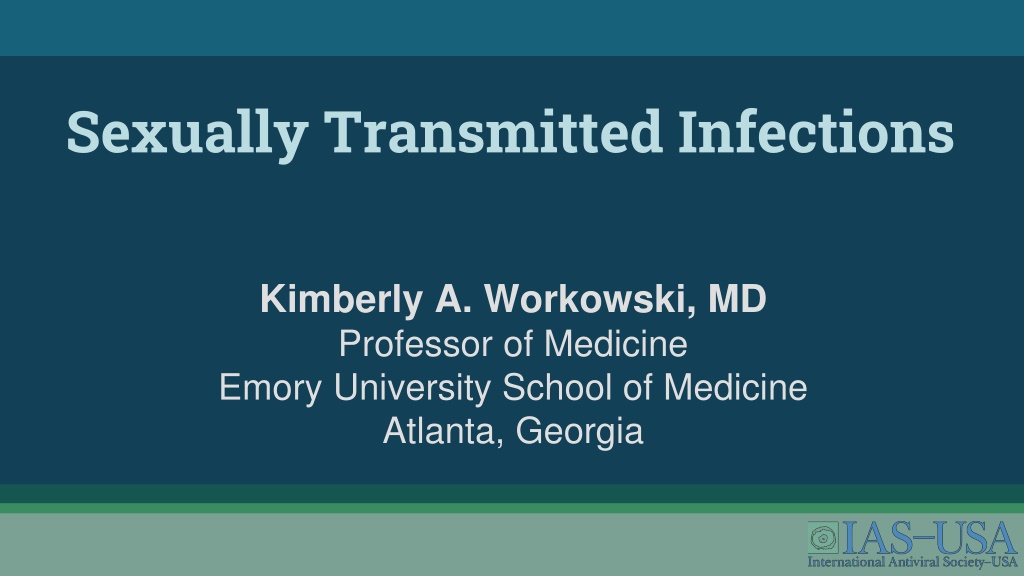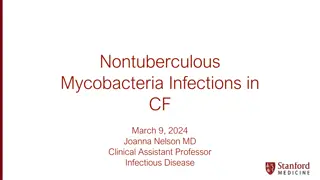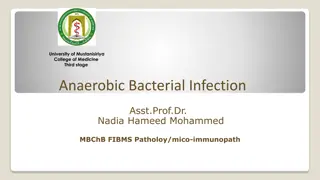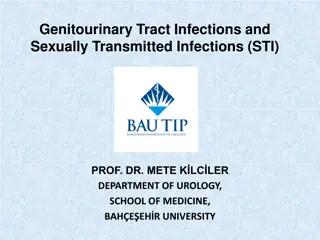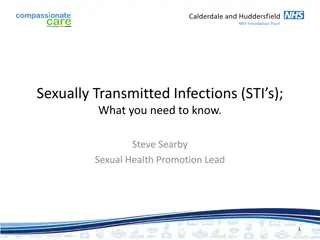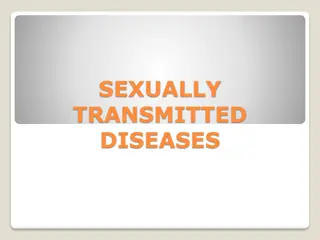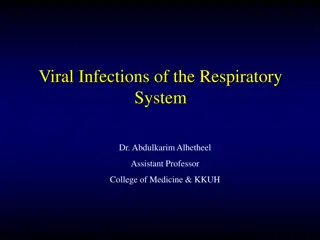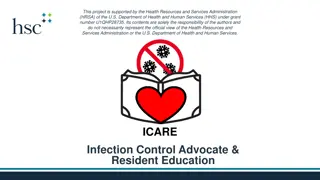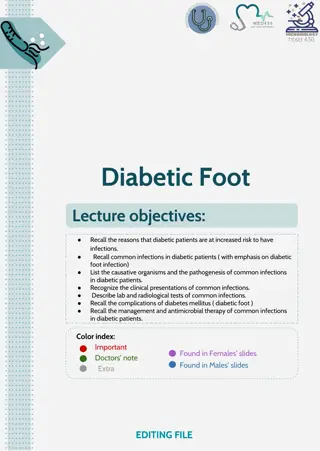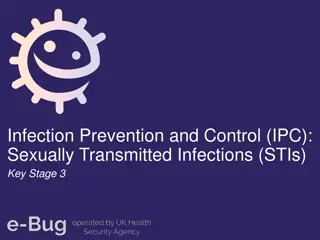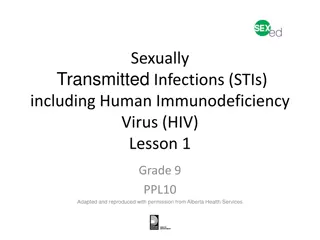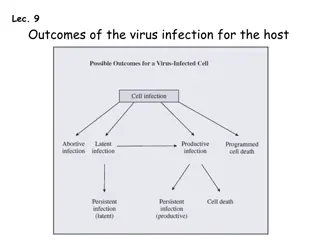Sexually Transmitted Infections
Current epidemiology, screening, and treatment recommendations for syphilis, gonorrhea, and chlamydia. Learn about rising STI trends, testing during HIV care, and syphilis serologic screening algorithms. Gain insights into evaluating CNS involvement.
Download Presentation

Please find below an Image/Link to download the presentation.
The content on the website is provided AS IS for your information and personal use only. It may not be sold, licensed, or shared on other websites without obtaining consent from the author.If you encounter any issues during the download, it is possible that the publisher has removed the file from their server.
You are allowed to download the files provided on this website for personal or commercial use, subject to the condition that they are used lawfully. All files are the property of their respective owners.
The content on the website is provided AS IS for your information and personal use only. It may not be sold, licensed, or shared on other websites without obtaining consent from the author.
E N D
Presentation Transcript
Sexually Transmitted Infections Kimberly A. Workowski, MD Professor of Medicine Emory University School of Medicine Atlanta, Georgia
Learning Objectives After attending this presentation, learners will be able to: Describe the current epidemiology of syphilis, gonorrhea, chlamydia Describe current screening and diagnostic recommendations Identify current treatment recommendations in the era of emerging antimicrobial resistance Slide 3 of 60
STIs are on the rise Limitations of case report data Not all STDs are nationally notifiable Most STDs are asymptomatic, only those diagnosed can be reported Trends are influenced by screening coverage and reporting practices Slide 4 of 60
Proportion of P&S Syphilis Cases that Reported Meth or Heroin Use or Sex with a PWID, 2012 2016 25% Women 20% Proportion of Cases MSW 15% 10% MSM 5% 0% Year Kidd, MMWR 2019; Feb 15 Slide 5 of 60
STI Testing during HIV care STI Testing during HIV care Initial care visit Syphilis serology, NAAT (gonorrhea, chlamydia) MSM (site of exposure) Hepatitis A,B, C Women Trichomonas testing (NAAT) Cervical pap test (HIV OI guidelines) Frequent screening dependent on risk (3-6 mo) New sex partner, partner with concurrent partners or more than one partner, or partner with an STI High risk behavior Partner services, prevention counseling 2015 Treatment Guidelines, HIVMA 2014 Slide 6 of 60
Syphilis serologic screening algorithms Traditional Reverse sequence EIA or CIA RPR Sensitivity Primary 62-78% Secondary 97-100% EL 82-100% Tertiary 47-64% NS (VDRL) 49-87% Quantitati ve RPR EIA/CIA+ EIA/CIA- RPR+ RPR- Early primary, requires RPR (active), false + Quantitative RPR TP-PA or other trep. test RPR+ TP-PA+ RPR- TP-PA- Syphilis Syphilis Syphilis unlikely (past or present) (past or present) TP-PA Active infection, F+, miss early TP-PA+ TP-PA- Syphilis Syphilis unlikely (past or present) MMWR 60(5);2011 Slide 7 of 60
Evaluation of CNS Involvement All persons with syphilis should be evaluated for neurologic symptoms/signs CSF examination recommended: Neurologic or ophthalmic symptoms/signs Auditory disease, cranial nerve dysfunction, meningitis, stroke, altered mental status, loss of vibration sense, iritis, uveitis Evidence of tertiary disease aortitis, gumma Serologic treatment failure CNS invasion in early syphilis is common CSF abnormalities of unclear significance in the absence of signs/symptoms Neurosyphilis = CSF tests + reactive RPR + signs/symptoms 2015 CDC Treatment Guidelines Slide 8 of 60
Syphilis Benz Pcn 2.4 mu IM x 1 early syphilis Role of enhanced therapy IM+oral (Rolfs 1997) Observational > 500 HIV+ - no difference in serologic outcomes at 12 months 1 vs 3 (Ganesan 2014, Yang 2014) RCT Benz pcn 1 vs 3 early syphilis (NCT 03637660) PCN alternatives (early, latent, NS) Doxycycline, ceftriaxone Optimal dose/duration Prevention -doxycycline prophylaxis Bolan, STD; Molina, Lancet 2018 Slide 9 of 60
LGV LGV Proctitis Proctitis MSM and women -+rectal chlamydia NAAT PCR based genotyping Protocolitis +/- perianal ulcers Presumptive tx (doxy 100 mg bid x 21 d) Painful perianal ulcers or mucosal ulcers presumptive therapy for HSV Short course therapy 7-14 d GUM clinic in UK (Simon, STD 2018) Slide 10 of 60
Disseminated Gonococcal Infection (DGI) Estimated to account for 0.5-3% of gonococcal infections Risk factors: female, menses, pregnancy, terminal complement deficiency Clinical presentation Monoarticular arthritis Skin lesions (petechial or pustular) + tenosynovitis + polyarthralgia Perihepatitis, endocarditis, meningitis Mucosal site infection often asymptomatic (NAAT) Antimicrobial susceptibility (AST) testing (culture) Slide 11 of 60
Gonorrhea Gonorrhea Optimize therapeutic regimen PK/PD (site of penetration) Concentration dependent vs independent Bacterial burden Mutational frequency to resistance Novel agents (Zoliflodacin, Gepotidacin) Treatment Failures Most treatment failures due to reinfection If treatment failure suspect, obtain culture/susceptibility test + ensure partner treatment United States Ceftriaxone 250 mg IM in a single dose PLUS Azithromycin 1 g orally in a single dose United Kingdom Ceftriaxone 1 gram IM in a single dose Europe (European CDC) Ceftriaxone 500 mg IM in single dose PLUS Azithromycin 2 gm orally in a single dose Japan Ceftriaxone 1 gm IV/IM in a single dose Slide 12 of 60
M. M. g genitalium enitalium Meta Meta- -Analyses Analyses Syndrome Summary risk estimate Studies accounting for CT (subset) NGU 5.5 (4.3 7.0) - Female Urethritis 2.2 (1.6 2.9) 2.1 (1.5 2.9) Cervicitis 1.6 (1.4 2.0) 1.9 (1.4 2.8) PID / Endometritis 1.9 (1.3 3.5) 2.0 (0.95 4.0) Preterm Delivery 1.9 (1.2 2.9) 2.3 (1.1 5.0) Spontaneous Abortion 1.8 (1.1 3.0) 2.3 (1.0 4.9) Infertility 3.0 (1.3 6.7) 3.7 (1.7 8.1) HIV 2.0 (1.4 2.8) - Taylor-Robinson & Jensen, Clin Microbiol Rev 2011; Lis et al., CID 2015 updated; Napierala Mavedzenge & Weiss, AIDS 2009 Slide 13 of 60
HPV Vaccine Nanovalent HPV Vaccine Types 6, 11, 16, 18, 31, 33, 45, 52, 58 FDA approved to prevent warts, cervical, vulvar, vaginal and anal cancer 2 doses for males/females aged 9-14 3 doses for males/females aged 15-26 Immunocompromised patients need 3 doses, regardless of age of initiation Slide 14 of 60
Cervical Intraepithelial Neoplasia Grades 2 and 3 Prevalence per 1000 Person- Years Among Female Enrollees in Private Health Plans Aged 15 39 Years, by Age Group and Year, 2007 2014 Flagg EW, Am J Public Health 2016; 106(12):2211 2218. Slide 15 of 60
STI Screening and Management STI Screening and Management www.cdc.gov/std/tg2015 Slide 16 of 60
